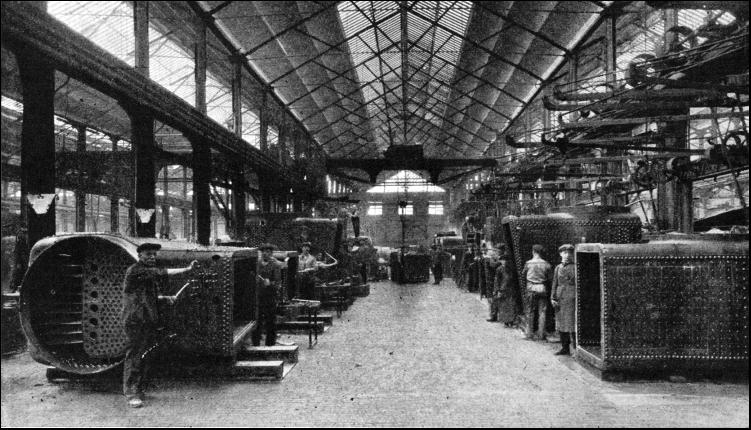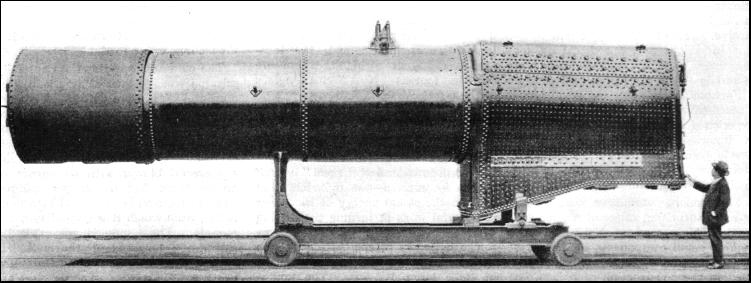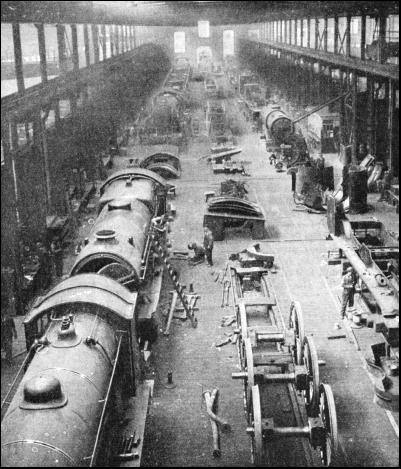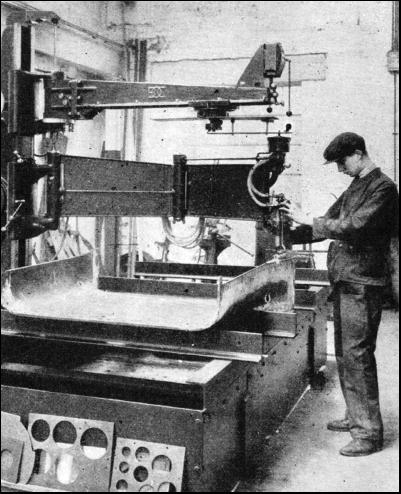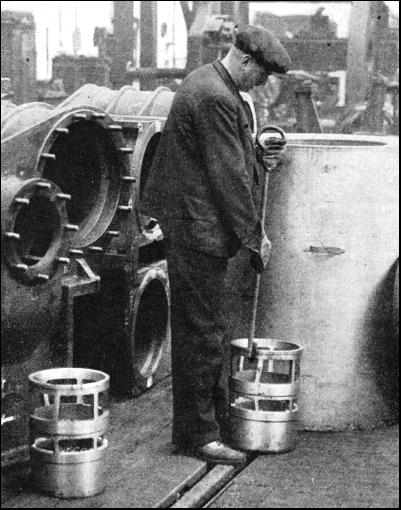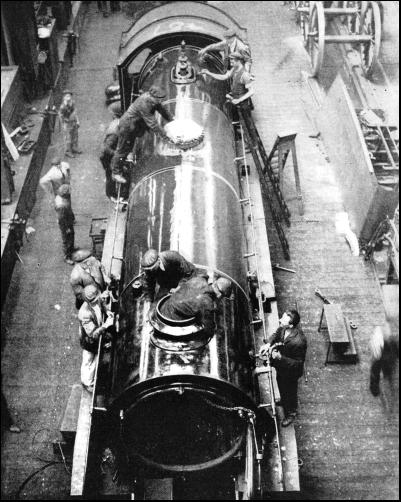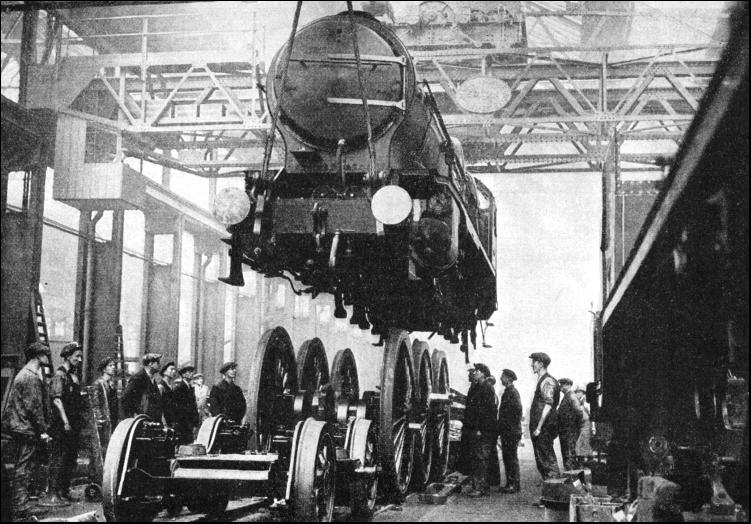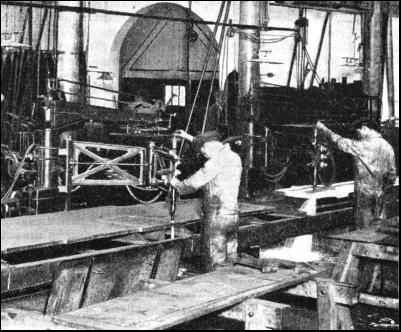|
|
ONE hundred and fifty tons of engine and five hundred tons of train at more than a mile a minute—that is the performance demanded of a modern express locomotive. There we have a combination of weight and speed calling for the finest possible workmanship, and materials of the utmost reliability. Fortunately, British locomotive engineers have over one hundred years of experience behind them, and this fund of knowledge, combined with great developments in machine tools and metallurgy, has made it possible to evolve the wonderful engines of to-day. The modern locomotive works comprises a surprising range of machinery, from the high-speed automatic machines making small components to the great hydraulic presses and rolling mills used in the construction of boilers. Engine-building methods vary slightly in detail, as between the railway companies that build their own locomotives and the engineering firms which specialize in the building of railway engines both for Great Britain and the ever expanding systems overseas. It will be more convenient, however, if we review the procedure at one of the largest works in England, the locomotive shops at Swindon, where are built the famous "King" class engines of the Great Western Railway. We will consider first the real "heart" of the locomotive—the cylinders that convert the steam energy of the boiler into useful work in turning the driving wheels. The cylinders of the "Kings," with their attached steam chests, consist of three large castings. The largest of these comprises the two inside cylinders, with their valve chests, and the curved saddle which supports the smoke-box. The two outside cylinders, with their steam chests, are cast separately. In all three castings, passages are provided leading to the exhaust steam injector, a device for utilizing part of the exhaust from the cylinders for feeding water to the boiler.
The cylinders are cast from specially selected iron, and the casting has to be absolutely free from defects. The iron is melted, together with a mixture of coke and limestone, in a cupola or vertical brick-lined furnace. The necessary forced draught is provided by a powerful blower with an output of 30,000 cubic feet of air per minute. The molten iron is drawn off into huge ladles, from which it is poured into the moulds. These moulds are made by embedding patterns of the cylinders in a special mixture of sand contained in strong iron boxes. The patterns are then removed from the sand, and "cores," also of sand, are inserted in the places where the bores of the cylinders and valve chests will be in the finished casting. Cores are used also for the steam and exhaust passages. The sides of the cylinder castings, together with the face of the smoke-box saddle, are carefully planed, after which the steam chests and cylinder bores are machined. The steam chests arc bored to receive the piston valve bushes in a special machine, which deals with all four of the inside cylinder bushes—two at either end—at the same time. Cylinder bores and piston valve bushes are finished in a large grinding machine. A battery of machines is in operation for drilling and tapping the bolt- and stud-holes in the casting, for securing the end covers, and for fixing to the locomotive's main frames. The fitting of the piston-valve bushes (or liners) into the bored holes in the cylinder castings is a particularly interesting operation. Everyone is familiar with the "shrinking-on" of iron tyres to wooden wagon wheels by heating. The nearly red-hot tyre is hammered over the wooden felloes of the wheel, and, on being cooled with water, the iron contracts and grips the wheel firmly. The same method is used for fitting steel tyres to locomotive wheels ; this will be described later. Valve bushes must be a dead-tight fit in their bores, and it is not practicable to heat up the huge mass of the cylinder casting and allow it to "shrink" over the liners. Here, then, the chemist takes a hand in engine building. The liners are ground a "shade" too large for the bores and are "shrunk up with the cold" before insertion. This shrinking up is accomplished by dipping the bushes in a tank of chemical freezing mixture, after which they are inserted into their holes. Once in position, the bushes regain their normal size, and are consequently a tight fit in the casting. The frames, forming the sides of the locomotive under-carriage, are cut from great steel plates, 3 ft. 6 in. wide, 1-1/4 in. thick, and some 41 ft. in length on a "King" engine. These plates are first rough-cut to the required outline—but the words "rough-cut" cover one of the most amazing developments in modern locomotive engineering. This preliminary cutting is done by means of a flame of coal gas, not unlike the familiar old-fashioned gas-jet in some ways, but with one vital difference. The jet is fed with oxygen gas under pressure, the resultant oxy-gas flame being capable of cutting through iron and steel as a warm knife parts a pat of butter.
This cutting jet of flame is held in a special machine with an arm overhanging the locomotive frame which is laid horizontally on trestles. Flexible pipes convey gas and oxygen to the jet. This movable arm carries, in addition to the jet, a small electric motor with a magnetized spindle. As this spindle revolves, it follows the edge of a small steel pattern or template, so that the jet on the end of the arm is made to travel in a similar but longer path. It will be seen, then, that by using a small template in thin sheet steel a large locomotive frame can be cut by the oxy-gas machine without the least difficulty. This method of cutting is far more accurate than is generally supposed, and very little machining remains to be done to finish the slots and holes so formed. The frames are next "dished" at the leading end in powerful hydraulic presses to provide clearance for the leading wheels of the bogie. Finally the frames are drilled, in pairs, with all the necessary holes for bolting on the cylinders, the buffer beams, the horn blocks which carry the axle-boxes, and the numerous fittings which go to complete the locomotive chassis. The axle-boxes are steel castings having gun-metal liners with white metal bearing surfaces, the latter being on the top half of the axle only, since none of the pressure on the axle-box is exerted in an upward direction. Oil is fed to all bearing surfaces of the axle-boxes by pipes leading from oil boxes carried on the frames. The bottom portions of the axle-boxes contain pads, saturated with oil, which are pressed on the underside of the journals by springs. The crank axle on to which the inside cylinders drive is built up from bars and slabs of steel. The slabs are machined and bored for the bars on to which they are shrunk, the assembly being turned in a lathe to form the crank pins and shaft. The wheels are of cast steel, bored to receive the axle ends, which are forced in hydraulically at a pressure of about 130 tons. The steel tyres are bored rather smaller than the diameter of the wheel, and are shrunk on to the wheels. In this operation the tyres are heated in a gas furnace so that they expand, and on being placed over the wheels they are allowed to cool. When they contract, of course, the tyres grip the wheels tightly. As a further safeguard a retaining ring is hammered down between a lip on the tyre and the rim of the wheel itself. Next the wheels are finished to size on a special lathe. The holes for crank or coupling-rod pins are then bored in a quartering machine, having two heads placed at right angles, so that both wheels are bored simultaneously at the correct angle. Finally, the wheels are tested in a special balancing machine, so that necessary adjustments can be made to ensure absence of vibration even at speeds equivalent to sixty miles per hour on the track. The "motion" is the moving mechanism which transmits the pressure of the steam to the driving wheels. The first item for consideration is the piston, which is forced backwards and forwards in the cylinder. The piston comprises a hollow iron circular box, provided with a pair of expanding rings similar to those fitted to petrol engines. The piston is screwed by a tapered thread to one end of the piston rod, which passes through a stuffing box and gland in the back cylinder cover. The stuffing box, as its name implies, is stuffed with flexible metallic packing and graphite paste, to ensure that no leakage of steam shall occur, while it permits the rod to slide freely to and fro.
Here it is necessary to digress a little on the working of the piston and its attendant mechanism. The end of the piston rod outside the cylinder is attached to the crosshead, a steel casting provided with "slippers" which move between two slide bars attached to a steel bracket at one end and the cylinder at the other. The connecting rod is pivoted on the crosshead at one end, the other extremity having a bearing on the crank-pin of the driving wheel. The function of the connecting rod is to transfer the thrust of the piston to the driving wheels, and it is consequently a very important component in the motion work. The connecting rods are machined from the highest quality steel to an I-section, giving maximum strength with minimum weight of material. The coupling rods, which are of rectangular section, link the driving wheels together, so that they all serve in transmitting the power. The bogie is built up with side frames, axle-boxes and wheels in a similar way to the construction of the engine itself. The locomotive tender chassis is built with framing similar to that of the engine. Water tanks, composed of steel plates, are riveted in place on the undercarriage, and brake gear, water pick-up apparatus, and other fittings are added to complete the tender. While the locomotive chassis has been under construction, the shops have been busy with the boiler. It is on the engine's steam generator that efficiency in service so largely depends. The boiler must be capable of raising steam quickly and in sufficient volume to supply the cylinders in all working conditions. Absolute safety in operation is, of course, essential, and provision must be made for cleaning at frequent intervals. In addition, the boiler must be so designed to conform to the limits of the space available on the engine chassis. Similar methods of construction are employed by most of the boiler engineers in Britain ; but as we are considering the building of a Great Western engine, the procedure adopted at Swindon Works will be followed through the various stages. One of the main features of the G.W.R. standard boiler is the coning or tapering of the barrel, so enabling the fullest use to be made of the intense heat at the firebox end. Another advantage lies in the relatively small space at the front end of the boiler, which prevents a forward surge of water with the attendant danger of uncovering the firebox crown plates. The boiler comprises three main components, the firebox, the barrel, and the smoke-box. The firebox consists of an inner box with an outer casing. The inner and outer fireboxes are joined at the bottom by an iron "foundation-ring," rectangular in shape and section. The inner box consists of the tube plate, the back plate, and the wrapper plates, all securely riveted together. The outer firebox is of steel and comprises a throat-plate which fits the barrel, and the back-head which is flanged with the copper back plate of the inner firebox to form the firehole. Finally, there is the wrapper plate, made in three portions—one crown and two side sheets riveted together. The barrel is built up from rolled steel plates. The front end is closed by a steel tube plate, drilled for the steel fire-tubes from the firebox. At the front end of the barrel also is riveted the smoke-box with its door, chimney, and important components, such as the superheater header, blast nozzle, and blower ring for inducing a draught for the fire. One of the most interesting processes in the building of a giant boiler for a modern locomotive is the shaping of the various plates that form the firebox.
The plates are flanged by means of great hydraulic presses that squeeze the metal over suitably shaped "dies." These dies are of cast iron, accurately machined to the correct shape of the finished plates. The steel throat-plate of an outer firebox provides a fine example of hydraulic flanging. The plate, 3/4 in. thick, is heated in a coal or gas fired furnace and is then transferred to the die block in the hydraulic press. The die block is warmed up before use to avoid chilling the heated plate when the two come in contact. There are two hydraulic presses in the Swindon shops operating at the enormous pressure of 1,500 lb. per square inch. The larger press exerts a pressure of 650 tons, the smaller a pressure of 200 tons. This large press will finish a steel throat-plate at one squeeze. After pressing, the rough edges of the steel plates are trimmed to size on a specially-arranged table. No machine tool is used for this operation—once again the remarkable cutting properties of the oxy-coal gas flame are brought into play, and the work is done with speed and accuracy. Barrel and wrapper plates are cut out by means of a portable oxy-acetylene flame cutting-machine. The flanging of copper plates is also done in the hydraulic press, but the operation is carried out "cold," no heating being resorted to as with the steel plates. At one time firebox copper plates were flanged by beating with wooden mallets after a preliminary heating. Boiler construction calls for rather more accurate workmanship than is generally supposed. Where a plate edge butts against another edge, the touching surfaces have to be carefully machined, and the fit of barrel plates one inside the other must be perfect.
The firebox wrapper plates and the barrel plates are rolled to shape in large bending rolls. The barrel plates are rolled conical throughout their length. The ends, however, have to be parallel, as the barrel rings fit one inside the other. To make the ends parallel a special press is used having a central block the same diameter as the inside of the barrel rings. Surrounding the centre block is a series of movable blocks, arranged spoke-fashion, which are forced inwards with a pressure of 1,500 lb. per square inch, so squeezing the shell ends to the correct shape. The next stage is the assembly, on separate jigs, of the inner firebox and the outer casing. A few temporary bolts are used to hold the various plates together while the rivet holes are drilled in special machines. After drilling, the plates are riveted together—no hammering, however, is allowed on this job. Once again use is made of hydraulic power. The rivets, are squeezed into place by a riveting machine with long jaws, between which are placed the plates to be joined. The foundation ring that joins the inner to the outer firebox is of Yorkshire iron, and is accurately machined by milling—rotating steel cutters removing the surplus metal and leaving a perfectly smooth surface. The inner copper firebox is next placed inside the steel casing with the foundation ring in position. A few temporary bolts are used to hold the boxes in place for the next operation, the drilling and tapping of the stayholes. In a locomotive firebox there are hundreds of stays—screwed metal rods that hold the plates together to prevent their bulging under the enormous pressure. The stay holes are drilled through a template or jig, to secure accurate spacing and position. A portable machine is used for this work, and both steel outer shell and copper inner firebox are drilled through at the same time to ensure perfect alignment. After the stays have been inserted the barrel is lined up with the firebox and held in place by temporary bolts for the final riveting to the throat-plate of the locomotive. The riveting is done in a powerful hydraulic machine with a gap 23 ft. in length. For this operation the whole boiler is lifted by an overhead crane and lowered between the jaws of the riveter. The riveting rams are worked from the same platform as the crane thus ensuring complete control over the riveting. At the front end of the boiler the smoke-box tube plate is riveted in position. Through holes drilled in this the steel fire tubes are inserted and expanded in place.
Front and back tube plates are also joined by longitudinal steel stays. Finally the boiler is taken in hand by the boiler mounting department for the fitting of safety valves, superheater, water gauges, and other accessories. The completed boiler is first tested under hydraulic pressure to some 40 lb. per square inch above the working pressure, and then at working pressure under steam. The boiler is given a coat of anti-corrosive paint and, after having been tried in the frames, the smoke-box is finally riveted to the barrel. This operation is left to the last, as the bolt holes in the smoke-box are marked off from those in the cylinder saddle casting. A locomotive boiler is bolted rigidly only at the front or smoke-box end, since the barrel must be free to expand longitudinally under heat. The firebox end is free to slide along the top edges of the frames, the supporting angles resting on springs and having other angles above them to prevent any lifting. We have briefly reviewed the construction of the various components of a modern locomotive and now come to the erection of the engine. First the finished frame plates are placed on low trestles and the more important locating lines are marked out on both sides. These lines show the positions of the cylinders, inside motion plates, saddle casting, valve-gear casting, frame cross-stays, and other main components. The frames are then lifted into a vertical position and mounted in adjustable forked stands. Cross-stays are temporarily bolted between the frames to ensure that they are the correct distance apart. Next the frame tops are set dead level and are tested both longitudinally and across with a spirit level. The frames are also set dead-square with one another and are additionally tested all over with long straight edges. Any slightly bent portions of the frames are straightened by hammering. The next operation is the fitting of the trailing "cheeks" of the leading "horns." The horns are the slots in which the axle-boxes slide up and down, and the cheeks are the flat bearings that take the thrust of the driving wheels as they push the engine along.
Inside cylinders and motion plate are now bolted temporarily in the frames. Their correct position is determined by a simple yet effective method. A cord or piano wire is passed through the bore of the cylinders, through the motion plate, and over a straight edge that coincides with an imaginary line between the centres of the leading horns. This ensures that the thrust of the pistons shall be delivered to the crankshaft at exactly the correct angle. Valve gear and saddle castings are next tried in the frames, and holes for the carrying bolts are marked off. The castings are removed for drilling and are then temporarily bolted between the frames to ensure rigidity while the outside cylinders are fitted. When the framework is practically complete, as much as possible of the "inside" gear is fitted before the boiler is lowered on to the frames. Before final attachment to the undercarriage, the boiler is coated with a non-conducting composition of magnesia and asbestos, covered by thin plates of sheet steel. Preparations are next made for adding the wheels, or "wheeling the engine" as it is called. Axle-boxes are fitted to the axles, springs and equalizers, eccentric sheaves and straps are secured in position, and pistons, valves, crossheads and air pipes are assembled. Finally the engine framework, complete with boiler, is lifted by an electric overhead crane and the driving wheels are run underneath. The locomotive is then carefully lowered in position on to the wheels. Coupling and connecting rods, valve and reversing gear are next fitted and the engine is ready for valve setting, an operation that may be compared with the valve timing of a motor-car engine. All dirt and grease are finally removed from the engine ready for painting and varnishing. The bogie is run under the front of the locomotive and secured in position, after which the springs on all wheels are adjusted so that each carries its correct proportion of the engine's weight. After a short trial run, the engine is employed for a time on local trains, and is then put into service for the working of passenger expresses.
Many thanks for your help
|
   Share this page on Facebook - Share  [email protected] |

